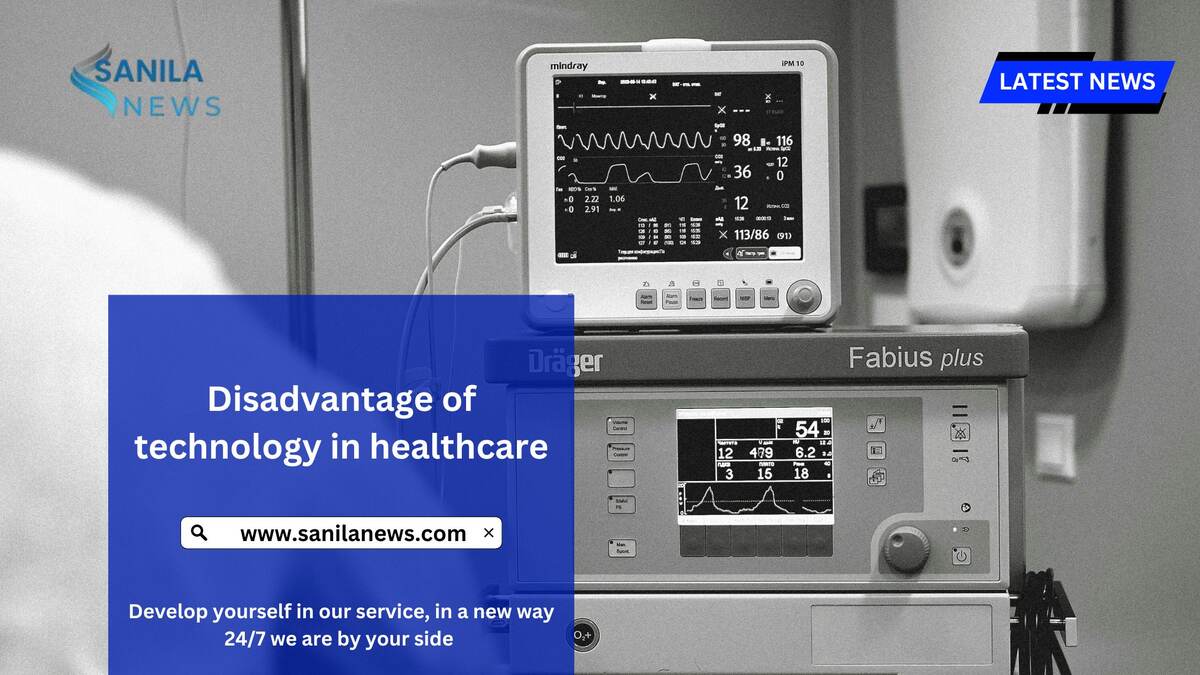Disadvantage of Technology in Healthcare
Disadvantage of technology in healthcare: The integration of technology in healthcare has transformed medical practices, leading to improved patient outcomes, faster diagnosis, and streamlined operations. However, despite its numerous benefits, technology also presents several disadvantages that have become apparent over the years. These drawbacks can impact patients, healthcare professionals, and the system as a whole. This article delves into the various disadvantages of technology in healthcare, exploring how these challenges affect the industry.
1.Disadvantage of technology in healthcare: Increased Costs
While technology is often introduced with the intention of reducing costs in the long run, the initial investment required to implement advanced healthcare technology is substantial. Hospitals and clinics must invest in cutting-edge devices, software systems, and staff training, which can result in financial strain, particularly for smaller healthcare providers. For instance, the adoption of electronic health records (EHR) systems, diagnostic equipment such as MRI machines, and telemedicine platforms all require significant capital investments.
Moreover, maintenance costs for technological systems, including updates, software patches, and equipment repairs, add to the ongoing financial burden. These expenditures can lead to higher medical bills for patients, as healthcare providers may pass these costs onto them.
2. Disadvantage of technology in healthcare: Job Losses and Deskilling
The automation of certain healthcare tasks due to technology can lead to job displacement for some healthcare workers. Administrative tasks, such as data entry, scheduling, and billing, are increasingly being handled by software, reducing the need for human involvement. Even within medical roles, some tasks traditionally performed by healthcare professionals, such as taking vitals or performing certain diagnostic tests, can now be automated through AI and machine learning algorithms.
This shift can lead to job losses, particularly for workers in administrative and lower-skill healthcare positions. Moreover, there is also the issue of deskilling, where healthcare professionals rely heavily on technology for diagnosis and decision-making, potentially eroding their critical thinking and problem-solving abilities. The over-reliance on technology can diminish a clinician’s expertise, as they may defer to automated systems rather than using their own judgment.
3. Privacy and Security Concerns
With the digitization of medical records, patient data is increasingly being stored and transmitted electronically. This raises significant concerns regarding data privacy and security. Health records contain sensitive personal information, and breaches can lead to identity theft, medical fraud, or even threats to patient safety.
Despite advancements in cybersecurity, healthcare organizations remain vulnerable to data breaches and hacking attempts. In fact, healthcare data breaches are among the most common and costly. Hackers target healthcare databases because of the wealth of valuable information they contain. Additionally, insider threats—whether through negligence or malicious intent—can also lead to breaches.
A famous case that highlights this issue is the 2017 WannaCry ransomware attack, which affected the National Health Service (NHS) in the UK. The attack disrupted hospital operations, forcing cancellations of appointments and causing delays in patient care. Such incidents underline the potential for technological vulnerabilities to harm healthcare operations and patient well-being.
- Technical Failures and Downtime
Disadvantage of technology in healthcare: No technological system is immune to technical glitches or failures, which can severely disrupt healthcare services. Equipment malfunctions, software bugs, and network outages can delay patient care, sometimes with serious consequences. For example, a malfunctioning diagnostic tool or a failure in an EHR system can result in misdiagnoses, delayed treatments, or errors in patient records.
Healthcare institutions increasingly rely on interconnected digital systems. If one part of the system goes down, it can affect multiple departments. For example, if an EHR system fails, clinicians may be unable to access crucial patient data, including medical histories, allergies, and medication information. This not only impedes the immediate provision of care but also increases the likelihood of medical errors.
5. Loss of Human Touch in Care
One of the most frequently cited disadvantages of technology in healthcare is the loss of personal interaction between healthcare providers and patients. While technology offers convenience, it can also depersonalize the healthcare experience. Many patients value the relationship they build with their healthcare providers, as it fosters trust and reassurance. However, as technology takes over tasks such as diagnosis, monitoring, and communication, the human element of care can diminish.
For instance, telemedicine allows patients to consult doctors remotely, but it also limits face-to-face interaction. While this can be convenient for minor health issues, it can reduce the empathy and attentiveness that patients often seek during medical consultations. The heavy use of screens and devices during in-person consultations can also make patients feel disconnected, as clinicians may spend more time inputting data into a computer than engaging with the patient directly.
- Ethical Dilemmas
The increasing role of artificial intelligence (AI) and machine learning in healthcare has given rise to several ethical concerns. These technologies are being used for diagnostic purposes, predicting patient outcomes, and even determining treatment plans. However, AI systems operate based on algorithms and data, which can sometimes result in biased outcomes or decisions that do not consider the unique circumstances of individual patients.
For example, AI-based decision-making systems may inadvertently perpetuate biases present in the data they were trained on, leading to unequal treatment for certain demographic groups. There have been instances where AI systems in healthcare have shown racial bias in predicting health risks, as they were trained on datasets that underrepresented certain populations.
Furthermore, the use of AI in healthcare raises questions about accountability. If an AI system makes an incorrect diagnosis or treatment recommendation, it becomes difficult to determine who is responsible—the machine, the software developers, or the healthcare provider who relied on the system.
- Disadvantage of technology in healthcare: Overdependence on Technology
The increasing reliance on technology in healthcare raises concerns about overdependence. When clinicians depend too much on technology for diagnosis or treatment planning, they may neglect to use their own clinical judgment or critical thinking skills. While technology can provide valuable insights, it is not infallible, and errors can occur. For instance, AI diagnostic tools may not always account for nuances that an experienced clinician would notice.
This overdependence can be particularly problematic in emergency situations when technology may fail or be unavailable. In such cases, healthcare professionals need to rely on their training and experience to make swift decisions, but over-reliance on technology could hinder this ability.
- Inequality in Access
While technology can improve healthcare accessibility for many, it can also exacerbate inequalities, especially among marginalized populations. Advanced healthcare technologies are often available only in well-funded hospitals and clinics, typically in urban areas. This leaves rural and underfunded healthcare facilities with fewer resources and outdated equipment, limiting the care they can provide.
Furthermore, as healthcare services increasingly move online—such as with telemedicine—patients who do not have access to reliable internet or smart devices are left out. The digital divide means that low-income individuals, the elderly, and people living in remote areas may struggle to benefit from technology-based healthcare services.
For example, during the COVID-19 pandemic, many healthcare providers transitioned to telemedicine. However, patients without access to technology or the internet faced challenges in receiving care. This digital exclusion can deepen existing healthcare disparities, making it difficult for certain populations to access timely medical attention.
- Medical Errors and Miscommunication
Technology in healthcare has the potential to reduce errors, but it can also introduce new avenues for mistakes. One of the main sources of concern is the possibility of miscommunication between different systems or between healthcare professionals and the technology itself.
For instance, EHR systems are meant to streamline communication between different departments and healthcare providers, but they can also contribute to medical errors if data is input incorrectly, if there are software bugs, or if healthcare professionals misinterpret the information displayed. Additionally, automated systems may generate alerts or recommendations that are ignored or misunderstood by clinicians, leading to incorrect diagnoses or treatments.
Similarly, AI diagnostic tools, while often accurate, are not foolproof. Errors in these systems can lead to misdiagnoses or inappropriate treatments. Furthermore, when healthcare professionals rely too heavily on these tools without verifying their results, the risk of error increases.
10. Training and Adaptation Challenges
The constant evolution of healthcare technology necessitates ongoing training for healthcare professionals. However, not all practitioners are equally proficient with new technologies, and many may struggle to adapt to rapidly changing systems. The time and effort required to learn how to use new devices or software can be burdensome for clinicians who are already stretched thin.
Additionally, inadequate training can lead to improper use of technology, increasing the risk of errors. For example, if a healthcare worker does not fully understand how to operate a new diagnostic machine or input data into an EHR system, it could result in misdiagnosis or incomplete patient records. The learning curve associated with new technologies also has the potential to reduce efficiency in the short term, as healthcare workers adjust to using new systems.
Conclusion
Disadvantage of technology in healthcare; While the advantages of technology in healthcare are undeniable, the disadvantages cannot be ignored. The potential for increased costs, job losses, privacy concerns, technical failures, and ethical dilemmas all pose significant challenges. Additionally, overdependence on technology, unequal access, and the risk of medical errors highlight the need for caution in its implementation.
To mitigate these disadvantages, healthcare providers and policymakers must take a balanced approach to technology adoption. This includes investing in robust cybersecurity measures, providing adequate training for healthcare professionals, and ensuring that technology is used to complement—not replace—human expertise. Only by addressing these challenges can healthcare systems fully harness the potential of technology while minimizing its risks.
Last word
Keep an eye on our news channel Sanila News to get updated news regularly.

